Peter MALONE
Saturday, 18 September 2021 19:24
Red Garters
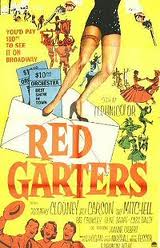
RED GARTERS
US, 1954, 91 minutes, Colour.
Rosemary Clooney, Guy Mitchell, Gene Barry, Jack Carson, Pat Crowley, Cass Daley, Frank Faylen, Reginald Owen.
Directed by George Marshall
Red Garters was an offbeat musical for its time. There are echoes of it in some of the M.G.M. musicals e.g. Seven Brides for Seven Brothers. Later stylised musicals were taken for granted - so in many ways this is a pioneering effort. Direction is by George Marshall, a veteran of many action films and comedies. The cast is lively, including Rosemary Clooney and comedian Jack Carson. Popular singer of the time Guy Mitchell has a comic role and later 'heavy' Gene Barry has a singing-dancing role. The sets were all stylised with striking use of colours. The screenplay was full of the conventions of the west which were being sent up. Audiences can enjoy the conventions as well as the satirising of them. Songs are by Jay Livingston and Ray Evans.
1. An entertaining musical? Western? The intentions for musical comedy, western spoof? How successful? 150s? Later? Influence on subsequent stylised westerns e.g. Seven Brides for Seven Brothers? Blazing Saddles?
2. Colour photography, sets and their stylised form, colours? Decor? The purpose of the stylised presentation of the musical? Editing and patterns? The stylised choreography: fights, dancing?
3. The pleasant musical score by Livingston and Evans? With a Hoot and a Holler etc.? The brightness of the music, the dancing? The satire on the west - and the message critical of western traditions? 'The code of the west'? The rowdiness? Songs about the roles of men and women - stereotypes? The ballads? The contribution of the various stars and their singing styles - especially Rosemary Clooney and Guy Mitchell?
4. The introduction, the westerns - being like the movies and movies being like the westerns! The invitation for spoof?
5. The conventions of the west and their being parodied? The hero and villain in white and black? The revenge themes? The mock shoot-outs? Heroines acting heroically? The code of the west, law and order? The visitor from Out East to investigate the west?
6. Limbo and Paradise Lost? The opening barbecue and picnic and celebrations? Life in the town? Hotels, saloons, dancing? Clothes, behaviour? The satire on California?
7. The code of the west and revenge? The serious side of the spoof? 'Goodbye Jay and Joe'? Expectations? The duel being thwarted and turned into a joke? The real killer - and the serious-comic ending?
8. The atmosphere of romance: the roles of men and women? The tough heroine? Jason and his eyes, pride? Sheila and her coldness? Adapting to the west? Susana as the town belle? Minnie and her comedy? Reb and his naivety? Calaveras Kate and her control of the town? The fall, the hurt, the shooting etc?
9. Rosemary Clooney as Calaveras Kate - strength, holding the town together? Jason and her control of him - and he thinking he was in control?
10. The comedy style with Cass Daley as Minnie?
11. The judge, the fuss, Boston background, being knocked out?
12. Satisfying entertainment? Another angle on the west? The blend of the Hollywood musical traditions with the humour of the west?
Published in Movie Reviews
Published in
Movie Reviews
Tagged under
Saturday, 18 September 2021 19:24
Red Flag: The Ultimate Game
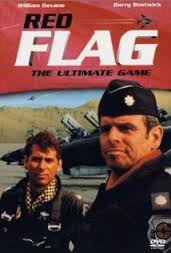
RED FLAG: THE ULTIMATE GAME
US, 1981, 100 minutes, Colour.
Barry Bostwick, William Devane, Joan Van Ark.
Directed by Don Taylor.
Red Flag: The Ultimate Game is a film about top fighter pilots and their training, especially realistically simulated air combat games in the Nevada Desert. The film focuses on their flights, manoeuvres, dangers and crashes. It also focuses on the characters, the types who want to become top pilots and top guns. The script, by T. S. Cook, goes below the surface of the ‘aerial jocks' and shows the effect of their competitiveness and aggressiveness on themselves, their marriages. Barry Bostwick and William Devane are the arch rivals. Joan Van Ark has a good role as the hero's wife.
The film can be seen in the light of attitudes towards the Soviet Union in the '70s and '80s, the readiness of the American Air Force for aerial combat (including having games in which one team is Soviet). Comparisons might be made with the box office success of 1986, Top Gun. Direction is by former actor Don Taylor, a director, continuously from the '60s to the '80s of many films and telemovies.
1. Interesting drama? Based on fact? The background of the American Air Force and their manoeuvres and games? Human drama? Pro- or anti-war?
2. Nevada locations, aerial and combat photography? The background of as Vegas? Musical score?
3. The title and the focus on the game, the focus on the American Soviet attitudes? The nature of war games? How seriously should war games be taken?
4. The need for this kind of war game? Readiness for combat? Testing of the men and the machines? The manoeuvres? The dangers inherent in the game? The effect on the controllers and their playing games with people's lives? The effect on the participants, competitiveness and aggressiveness?
5. Jay and his years in Vietnam, friendship with Phil, friendship with Frank? The strength of his marriage with Marie? In the games with Frank and Frank's mistake? His growing competitiveness, the offer of a civilian job and his not wanting it? Comparisons with Phil and his wanting to outdo him? Phil's provocativeness? Marie and her plain talking, love for her husband, trying to tell him the truth? Their fights? His going with Phil, the gambling, drinking, insult to Frank? The flights, the evading techniques? Using them with Phil and Phil's death? Coming to his senses? The inquiry, his wanting to take responsibility, Phil’s girlfriend, his mother, Marie saving the day at the funeral? His asking Marie her opinion, his deciding to resign, his seeing the new pilots, his continuing to help them? The exploration of his character in this situation?
6. Marie and her love for her husband, the time at Las Vegas, trying to tell him the truth, Frank's accident, support of Elaine, her dislike of Phil? The visit to the doctor and the understanding about aggression? The fights with Jay? Going to the control room and Phil's death? Her stepping in at the funeral? Sharing his final decision? Phil as the daredevil, years in Vietnam, top pilot, his divorce, happy-go-lucky, competitive with Jay, Heinz and the rumour about his giving in, the final competitiveness and his death? His girlfriend and her bitterness? His mother and her friendship with Jay?
7. Frank and Elaine, marriage, Las Vegas, Frank and his computer knowledge, the mistake? The crash and his bailing out? Injury? Spurned by Jay, Jay reckless on the road with Elaine? Talking over things at the end?
8. The doctor and his comments about aggression? Explaining what was happening to the pilots?
10. Colonel Anderson and his friendship with Jay, his advice, using the manoeuvre, sitting in on the investigation?
11. The investigating panel, facts and figures, personal responsibility? Jay and the effect of wanting to take the responsibility?
12. An interesting drama, about the American forces, insight into armed forces and their training, the repercussions on their personal lives?
Published in Movie Reviews
Published in
Movie Reviews
Tagged under
Saturday, 18 September 2021 19:24
Red Badge of Courage, The
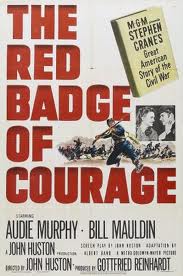
THE RED BADGE OF COURAGE
US, 1951, 69 minutes, Black and white.
Audie Murphy, Bill Mauldin, John Dierkes, Royal Dano, Andy Devine, Arthur Hunnicut.
Directed by John Huston.
The Red Badge of Courage, a minor film in its time and released as the supporting half of a double bill, has become something of a minor classic. Stephen Crane's story of a young innocent in the Civil War is archetypal material for interpreting the American hero. The setting of the Civil War is important - not in the ultra-heroic tradition of Hollywood, the God With The wind scale, but with the preoccupation of the ordinary men, called up without quite knowing why and involved in the horrors of American fighting American. All this is captured realistically and symbolically in the film.
Audie Murphy, the most decorated American soldier from World War Two, had achieved something of a career in the '50s with competent westerns. Here he has a chance to do something different and rises well to the demands. He was to make interesting films like Joseph Mankiewicz The Quiet American and John Huston's The Unforgiven. Commentators have written of the visual poetry of this film. However, there is a long story be hind its production. There were many clashes at M.G.M. at the time, especially amongst executives. There were re-writes of the film and a great deal of editing especially after John Huston, the director. left for Africa to make his next film, the classic The African Queen. Much of this material is covered in John Huston's autobiography; but there is a very well written book about Hollywood and film-making called Picture by Lilian Ross. It focuses completely on the difficulties in the making of The Red Badge of Courage. This book has been set as a school text and is worth study in itself. It provided many insights into the background of the making of this film. There was a telemovie remake in 1974 starring Richard Thomas in the central role with Michael Brandon and Wendell Burton. Direction was by Charles B. Fitzsimons.
1. How enjoyable was this film? As a war film, as a human document, as the filming of a classic?
2. Comment on the modesty of the film's scope and yet its homage to Crane and to American history. Does it deserve to be considered a film classic?
3. The quality of the black and white photography and its atmosphere, the use of music and its heaviness - appropriate? The filming of the strategies of battles compared with the close-ups of the personalities?
4. How successful was the narrative technique? For information, its total effect, as partly distancing the audience from the action, as making demands of the actors to illustrate the commentary? The focus of the book itself? The closing of the book at the end?
5. The importance of Stephen Crane as the author? As a young man of 22 and matching the use of the book?
6. The picture of war: for America, the rebel calling to the youth, the capturing of the rebels? The realities of war, the greatness of war, the uselessness of war, volunteering, training, the desire for action, the patriotic songs for each side, the flag, the fears and running away, the Red Badges of Courage? What insight into the situation of war did the film give?
7. How important for the film was a war in America? The feeling for an American war, American courage, the fact that it was a civil war and not an overseas war?
8. How interesting was the characterisation of the youth? How did he engage audience sympathy? How did the film try to draw our sympathy? His being called The Youth rather than his name predominantly, his age, as a volunteer, as a deep and sensitive young man, yet his fears, his tears, unwilling to admit apprehension? His interaction with the other men? His basic courage and yet the reality of his fear? The effect of the encounters with the wounded? Telling lies, returning? What made his so courageous at the end? His heroism? The need for telling the truth, yet his half-telling the truth? How had he grown and matured by this experience? His experience of life and death? How was he a symbol of America's youth and the basis for its future?
9. What was audience response to the other soldiers? How convincing were they in their realism and their personalities? The hillbilly soldier, his companion, the soldiers sunning away, the Captain, Jim and his death etc.? The General?
10. How were these soldiers symbols for attitudes of persons in war? The tall soldier Jim at his death, the ragged wounded soldiers, the talk amongst themselves, the nature of the fighting and its representation of human feelings and fears, the significance of deaths? The role of the General and his morale boosting, his talk about supper etc.? His prayer in battle?
11. How effective was the filming of the battles? The impact of the reality of war, charges, deaths, bullets and bayonets? Wounds? Its impact in the fighting in America itself, the landscapes, the birds singing after the smoke passed away?
12. What is heroism and what motivates it? Its illustration in this film?
13. The film as a portrayal of humanity? Limited with good and bad yet so real?
14. What are the classic qualities of this film?
Published in Movie Reviews
Published in
Movie Reviews
Tagged under
Saturday, 18 September 2021 19:24
Rebecca
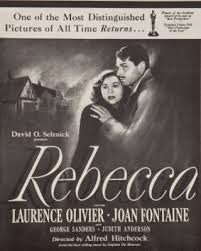
REBECCA
US, 1940, 130 minutes, Black and White.
Laurence Olivier, Joan Fontaine, George Saunders, Judith Anderson, Nigel, Bruce, Florence Bates.
Directed by Alfred Hitchcock.
Rebecca won the Oscar for the best film of 1940. It was Alfred Hitchcock's first American film. Hitchcock had a great reputation in England with such thrillers as The Thirty Nine Steps and The Lady Vanishes. David Selznick wanted him to come to Hollywood. Hitchcock liked America and has lived there for the rest of his life, returning to England to make particular films like Under Capricorn or Frenzy. Hitchcock had just made the film version of Jamaica Inn from the novel by Daphne Du Maurier. Later he was to make The Birds by the same author. Rebecca was a very popular novel at the time and Selznick, who had just finished Gone With The Wind, and knew the public's delight in film versions of popular novels, wanted to make this film. He secured the services of Laurence Olivier who made an impressive dramatic and melancholy hero.
Many tests were done of most Hollywood actresses for the role of the heroine of the film. Joan Fontaine won the role and was perfect in it. She was to win an Oscar under Hitchcock's direction the next year for Suspicion. One of the most memorable characters in Rebecca is Judith Anderson's Mrs. Danvers, the model of sinister housekeepers. George Sanders and Florence Bates were most impressive in the supporting cast. The film is not so much a crime thriller as a romantic melodrama and, to that extent, not so typical of Hitchcock. However, it was appealing in its time and has remained something of an enjoyable classic. Elements of Rebecca have influenced many filmmakers, one of the most notable is Brian de Palma who allows Hitchcock themes and styles to influence such films as Sisters and Obsession. Rebecca is certainly most entertaining.
1. The film is considered a Hitchcock classic. Why? It was 'Best Film of 1941'. What qualities impress now? What qualities seem dated?
2. Hollywood and its film styles of the 40s? Olivier and Fontaine, studio sets, the nature of editing, the musical background, black and white photography?
3. Hitchcock and his reputation? How does this film fit into it and contribute to it?
4. Daphne du Maurier and her romantic novelettes? The quality of this story as romance and as novelettish? Is the story strong? What is its main interest and appeal?
5. The significance of the title and the fact that Rebecca never appears? That she is talked about? How real is her impact? The particular incidents that she lived through? The particular objects that signified her? How real does her personality become? The contrast with Joan Fontaine and her never being referred to by her name? Her taking Rebecca's place, differing from her?
6. The importance of the structure of the film: the dream, the impact of Mandalay, the French locations, the journey, the substitution in love and hate, the climax and the truth? How well was the audience involved in this?
7. How attractive was Joan Fontaine as the heroine? The presentation of her background, her girlishness, her falling in love and worshipping Maxim? The importance of the wedding, her new way of life, her initial embarrassment? Her trying to live the life at Mandalay? Her girlish fears? The importance of the home movies? Her being haunted, the relationship with Mrs. Danvers, the dress? Her being reassured by Maxim? Her supporting him? Her growth from girlishness to womanhood? How rounded a characterization was this? How real a character?
8. The contrast with Maxim? His brooding, Laurence Olivier's performance? The initial melancholy, the falling in love, the using of the girl? The enigma, the mixture of tenderness and aloofness? The anger? The truth? The tricking of the audience? Audience sympathy towards him? The rich man who suffers? Olivier's skill in communicating the character eg. in his narration of Rebecca's death?
9. The malice of Mrs Danvers? Her menace, her devotion, her madness, her relationship with Favell, the melodrama of her death? She is considered the classic 'menacing housekeeper'. The quality of this performance?
10. Favell: Callow, blackmail, his attitude towards Rebecca, to Maxim, the realization of the truth?
11. The complications of the truth? Rebecca’s attitude towards life? The reality of the incidents in the boat, her death? The trick of the other body being found? Audience involvement in this?
12. The contribution of the minor characters for atmosphere, interest: Mrs. Van Hopper, the doctor, the relations? Their contribution to the understanding of Maxim, Rebecca? The irony in these characterizations, eg. Mrs. Van Hopper's snobbery?
13. Comment on the film's attention to detail, of Mandalay, of characterization.
14. The value in the exploration of themes of marriage, love, hatred?
Published in Movie Reviews
Published in
Movie Reviews
Tagged under
Saturday, 18 September 2021 19:24
Re-Animator
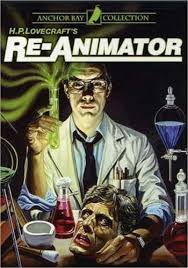
RE-ANIMATOR
US, 1985, 83 minutes, Colour.
Jeffrey Combs, Bruce Abbott.
Directed by Stuart Gordon.
Re-Animator is something of a cult horror classic. It is probably the most respectable of the horror splatter movies so popular in the early and mid 70s. The film has the courage of its convictions - employing special effects and gory style to horrify audiences. However, it probably gets away with its content and style because of the tongue-in-cheek satirical approach to its subject and treatment.
The film is based on a story by H. P. Lovecraft. The Dunwich Horror). it plays with the familiar horror science-fiction themes of life after death, reviving corpses - a kind of burial alive. The gory scenes draw attention to themselves - and are particularly ugly for sensitive audiences. However, they are also exaggerated - and played for black laughter.
The film was shown originally at some film festivals throughout the world.
1. The immediate impact of the film? For what audience was it designed? Festival exhibition? Cult status.~
2. The literature of H.P.Lovecraft? Horror themes and style? Medical background? Themes of life and death, playing God, exercising power, lust and abuse?
3. The Swiss opening, the Massachusetts medical background: hospital, laboratories? Morgues? The city and its apartments?
4. The contribution of the special effects: the initial distortion of the doctor's face, the dead bodies, the use of blood, the separated head and its movements, the splatter style? impact, good taste, grossness, crassness - the effect of excess?
5. The opening with Herbert West and Dr. Gruber: the intensity of West, his theories, trying to revive Dr. Gruber? His return to the United States, his intensity, disagreeing with Dr. Hill? The apartment with Dan? The cat and his killing it, his reviving it? Explanations to Dan and getting him on side? The hostility of Meg? The trick to get into the morgue? The test, the revived corpse and having to kill it? Being caught by Dean Halsey, battering him? Dr. Hill and his stealing West's theories? West hacking his head? The confrontation with the headless body? The final confrontation with Dr. Hill, the revived corpses, the strangling intestine? A picture of the mad scientist, theories, intensity, playing God?
6. Dan as hero, his concern about the heart patient, wanting to revive her? The attitude of colleagues? Relationship with Meg? The encounter with Herbert, renting the apartment, the incident with the cat, its being revived, his explaining things to Dean Halsey, his being dismissed, getting Herbert into the morgue, the experiments and their consequences, Dean Halsey and his madness, Dr. Hill, Meg and her being taken, the final fight, her death and his reviving her? The new Herbert West?
7. Dean Halsey and the administration, his love for his daughter, friendship with Dr. Hill, hard line in dismissing Dan, his going to the morgue, being battered, the padded cell, his death, his being controlled by Dr. Hill?
8. Dr. Hill and his plagiarising Dr. Gruber's material, against West, his being shown up in class, his eye for Meg, his experiments, stealing West's theories, his being killed, the head and the body reviving, separating, his devices to function as separated head and body (ingenious and comic)? Taking Meg, reviving the bodies as zombies and his controlling them? His intestine killing Herbert?
9. The ranges of corpses in the morgue, their revival, the film's focus on the manner of death, the agonising resuscitation?
10. The blend of the horrific, serious and tunny?
11. Themes of life and death, science, laws, ethics? The effect of living as dying - and Meg's final scream?
Published in Movie Reviews
Published in
Movie Reviews
Tagged under
Saturday, 18 September 2021 19:24
Real Glory, The
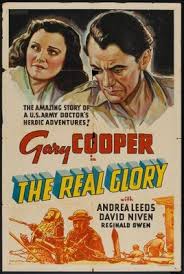
THE REAL GLORY
US, 96 minutes, Black and white.
Gary Cooper, David Niven, Broderick Crawford, Andrea Leeds, Reginald Owen, Kay Johnson, Russell Hicks, Vladimir Sokolof.
Directed by Henry Hathaway.
The Real Glory is an action adventure film, typical of the adventure so popular in the '30s. Gary Cooper, the hero of this film, had appeared in several of these like The Lives of a Bengal Lancer. It was a period also of adaptations of Kipling like Gunga Din and The Light That Failed.
Direction is by Henry Hathaway, a noted action director of the '30s, though a director who moved comfortably through a range of genres including westerns. Cooper had worked with him in The Lives of a Bengal Lancer, Now and Forever, Peter Ibbetson, Souls at Sea. Cooper is the commonsensed humanitarian hero. David Niven and Broderick Crawford are his Kipling-like associates. The action is set in the Philippines - and shows the Americans present and participating in a local uprising. The film is generally Boys' Own adventure and romance - with a humanitarian and thoughtful touch about issues such as war, local peoples and their independence.
.
1. An entertaining action adventure? Boys' Own adventure style? A piece of Americana? The history of the Philippines?
2. Black and white photography, Philippine atmosphere, action sequences? Special effects for battles, the dynamiting of the dam etc? Rousing musical score?
3. The title and the focus on themes of honour and glory? Military? Discipline? Coming to the aid of oppressed peoples? Plar and its exploits? Human values - the real glory?
4. The situation in the Philippines: the presence of the army? The uprisings? The training of the Filipinos? The rebellious Moros? Battles? Occupation? Victory?
5. Dr. Canavan in this situation? The laconic Gary Cooper hero? Humanitarian? In a position to criticise the military? His place as a doctor? His professional behaviour? The wounding of Captain Hartley? .His recuperation but his growing blindness? Dr. Canavan and his stances? Decisions? His love for Linda? His relationship with Mc Cool and Larsen? Decisions? Action? Working with the Filipinos? Diversionary tactics? The final battles? The vindication of his stances?
6. Mc Cool and Larsen? Professional soldiers? Mc Cool's Irish background? His pride in being a soldier of fortune? His history and his family’s history? Genial? Larsen and his Swedish background? The big man not bright, his love for orchids? Their stances towards Captain Hartley? The decisions to be made? Their participation in the battles? The soldiers of fortune and their isolation? Way of life? Personal interactions? Interesting character studies of men in war?
7. Captain Hartley and his authority, the assassination attempt, his injuries, recuperation, his awareness of his blindness, his not telling anybody? His decision-making? Errors of judgment? The challenge by Canavan? The response of Mc Cool, Larsen and the other soldiers? His love fl or his daughter? Her being torn in the situation?
8. The presence of the American army? The revolt? The withdrawal of the troops? The officers training the natives? The attack of the Moros? The excursions and deaths? The stance of the priest - and his remaining? His final salute and its fatalism?
9. The presentation of the Filipinos, their fight for independence? The attack of the Moros - the Moro swordsmen, the natives in terror? The fanatical charge?
10. Military discipline, training, obedience to orders, military judgment? The tempering of drill and discipline with humanity?
11. Action sequences: the battles, ambush, the diversion of the river, the Moros attacking the garrison, the tree catapults with the soldiers and missiles?
12. The American presence in the Pacific? In the retrospect of later decades? The Americans working with the Filipinos for independence? A type of colonialism? The respect for Filipino traditions, religious customs - and the violation of these to threaten? The independence of the Philippines?
13. A piece of Americana? The blending of serious themes with popular action adventure?
Published in Movie Reviews
Published in
Movie Reviews
Tagged under
Saturday, 18 September 2021 19:24
Green Dolphin Street

GREEN DOLPHIN STREET
US, 1947, 141 minutes, Black and white.
Lana Turner, Donna Reed, Van Heflin, Richard Hart, Edmund Gwenn, Dame May Whitty, Frank Morgan, Reginald Owen.
Directed by Victor Saville.
A very popular entertainment of the mid-40s, it was the equivalent of the later all-star lengthy blockbuster. Directed by Victor Saville, more noted for being a producer than a director (making at this time The Green Years and If Winter Comes), the film was very entertaining and involving.
Focussing on the history of two sisters and mistaken letters leading to an unhappy marriage and the other sister going to a convent, the film had plenty of romance and adventure. Set in France, the action moves to Hong Kong and finally to a spectacular New Zealand. Lana Turner was at home in this kind of role as the turbulent sister. Donna Reed was sweet and attractive as the good sister. Edmund Gwenn and Dame May Whitty, amongst others, are very effective in the supporting cast. The hero is the sturdy Van Heflin. Memorable are the earthquake sequences set in New Zealand and these are amongst the best of their kind. Popular entertainment, strong characterisations, action and good character studies, as well as plenty of themes in popular form.
1. How entertaining a film? Its impact now? A big-budget film of the 1940s, the characteristics of its style?
2. The quality of black and white photography, the stars, musical background? The sets and the re-creation of Saint Pierre, New Zealand, China? The special effects, the island and the earthquake? In comparison with film-making now?
3. Comment on the vast scope of the film. Comment on Its structure and the picturing of the generations. The comparison of the generations, the experience of the two families? How did this scope engage audience interest?
4. The background of Saint Pierre? France in the 19th century, the domination of the monastery physically, and morally? Life on the island and an isolated community? Their attitudes towards the sea and its opening to the world? The aristocracy and the ordinary classes on the island? The houses of the two families across the street? The symbolism of the way of life of the two families: the Ozannes and the Patourels? The nature of their interaction? Comment on the quality of life. The importance of this background for the interaction during the film?
5. The significance of the stories before the film opened? The deathbed truth? Sophie and her love for Edmund? Her growing in love for her husband? His knowledge of the truth? As indicating a theme of love and growing in love, as illustrated in the next generation? How true were these relationships, and how well explored? Comment on each of the characters of this generation.
6. The transition then into the lives of William, Marianne, and Marguerite? How was the truth of the previous experience illustrated In these three? The meaning of life, relationships and love? The interrelating of Ti and his experience in Saint Pierre's violence, his going to sea, and his entering into the lives of these three people in New Zealand? The meaning of fate, chance?
7. Comment on Marianne and Marguerite. The picturing of them together, their similarities as sisters, their differences in character, their love? What were the strengths and weaknesses of each sister? How were these developed during the film?
8. How idiotic was the mistake by William? How meaningless did it seem? And yet the wide-reaching effect?
9. Marianne and her wilfulness? Her determination to go, to have William? Her courage to make the voyage? Her marriage and her work in pioneering? Her love for William, her attitude towards Ti? The birth of Veronica and its impact? Making a new home In New Zealand? The impact of the earthquake, learning through experience, wealth and access? The importance of
her social life in Dunedin? The revelation in her return? The impact of her being hurt and having to cope? Strength of character through this crisis? What insight into the character of a strong and determined woman?
10. The contrast with Marguerite? The attractive and gentle sister? Her being hurt, her losing all possibilities of love? Tier staying, at home, her learning to adapt? Her life in the convent? The Mother Superior as knowing Sophie's experience and Marguerite's? Her true vocation and her remaining at the end?
11. What insight into the character of William? A weak man, devoted to his father, yet like his father? His mistake? Not revealing the truth? His working hard, making a life, changing? His renunciation of Marguerite? Making a future with Marianne?
12. The contrast with Ti? His melodramatic introduction into the film? His work in New Zealand? His love for Marianne and his control of this love? His helping William and Marianne? The revelation of the truth and its effect on the couple?
13. Comment on the film's detailed look at colonial life, pioneering in New Zealand, the lumber industry, the earthquake, the atmosphere of the Maori wars, an adventurous impact to the human relationships, successful social life In New Zealand?
14. What did the atmosphere of the sea, distances, travel and communication in the 19th century have in the film? The important role of Captain O'Hara?
15. The quality of the film as presenting human issues, historical values?
Published in Movie Reviews
Published in
Movie Reviews
Tagged under
Saturday, 18 September 2021 19:24
General Gordon Bennett
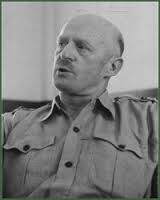
GENERAL GORDON BENNETT
Australia, 1988, 50 minutes, Colour.
Bill Kerr.
Directed by Stephen Wallace.
General Gordon Bennett was one of Willesee's Australians. The Australian Commander in Malaya in 1941, he clashed with the British General, experienced the invasion of the Japanese (so many on bicycle) and the surrounding of his troops. He chose to escape to Australia to warn about Japanese tactics rather than stay with his troops. He knew the risk that he was taking.. The framework of the film is 1945 and his going to the wharves in Sydney to see his men - and the worry about whether he would be accepted.
There was controversy about his stance - even though his rival General Blamey did the same in Crete. He spent most of the war in bitterness and obscurity. However, ultimately he was vindicated.
Bill Kerr gives a strong performance as Bennett. Direction is by Steven Wallace (Love Letters from Teralba Road, Stir, Mail Order Bride, For Love Alone). The screenplay was written by John Misto.
1. The impact of Willesee's Australians? A Bicentenary project? Highlighting Australian characters and spirit? General Bennett as one of Willesee's Australians?
2. The re-creation of the '40s: the Sydney wharves, Malaya, the battles in Malaya, Singapore and its siege? Musical score and atmosphere?
3. The focus on General Bennett? Audience knowledge of him? Of Australian troops in Malaya-and Singapore? Of the defeat of Singapore, the imprisonment in Changi? Attitudes towards Generals staying with their troops?
4. The portrait of General Bennett: Bill Kerr's presence and style, the framework of his uncertainty about his troops welcoming him? His relationship with his wife and communications with her during the war? A young General, his clash with the British, his driving his men hard, drilling them? His disdain of British tactics? His appreciation of the Japanese? His relationship with his troops, friendship with Walker? The experience of 1941-42? Headquarters, strategies, the Japanese on bicycles, the bombings? The morale-boosting and his disagreement? The clash with the General? The message to Churchill? The capture of the troops? His decision to go - the support of Walker, the criticisms of his officers? His return to Australia, disgrace and bitterness? His vindication? In retrospect?
5. The portrait of Australian soldiers at war, their drill, their stamina (and the parade with the man being sick)? There camaraderie, in the field, waiting for the Japanese in ambush, their talking about Singapore (and the sixpenny girls - and the Catholic refusing, and his being dead in a minute)? The hospital and the care of the sick, the Japanese and their massacring of the patients and nurses? The experience in Changi? Their return?
6. The officers, both British and Australian, strategy, morale, information and orders from England? The newsreels and the reaction of the British, of the Australians? The attitude towards the Japanese? Walker and his escape?
7. The picture of the Japanese, their invasion, the bike-riding, the massacres in the hospital? The background of Changi?
8. Memoir of World War II? A vivid re-creation of the period? Assessment of the period and the personalities?
Published in Movie Reviews
Published in
Movie Reviews
Tagged under
Saturday, 18 September 2021 19:24
Guadalcanal Diary
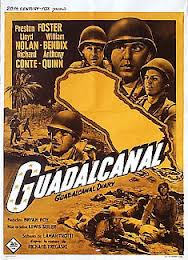
GUADALCANAL DIARY
US, 1943, 93 minutes, Black and white.
Preston Foster, Lloyd Nolan, William Bendix, Richard Conte, Anthony Quinn, Richard Jaeckel, Lionel Stander.
Directed by Lewis Seiler.
Guadalcanal Diary is based on a diary by Richard Tregaskis and the screenplay incorporates a voice-over which is rather literary and rhetorical. The film was a contribution by 20th Century Fox to the war effort in the Pacific. It is very gung-ho in many ways (at least seen in retrospect) with rather jingoistic and racist comments - although, the marines develop an admiration for the battle skills of the Japanese.
The film focuses on the first land battle of the war in the Pacific, only six months after the bombing of Pearl Harbor. The fleet and the marines went to the Solomon Islands, made a landing on Guadalcanal, the Japanese retreating. However, after some time the Japanese fought back and there was a very fierce battle. At the end of 1942, the marines pulled out and the army moved in to continue the war in the Pacific.
Preston Foster gets top billing as the chaplain from Notre Dame University, a commonsensed man's man chaplain. William Bendix has the opportunity for some comedy, harking back to Flatbush and Brooklyn. Very young Richard Conte, Anthony Quinn (in his twenties still but looking older) and Richard Jaeckel as a teenager appear as some of the troops.
The film is an interesting re-creation, done so soon after the actual battle, of the war in the Solomons.
1. The impact of the film in its time? War propaganda? The war effort? Morale-boosting? A portrait of American marines in action in 1942?
2. The situation of the war at that stage, the bombing of Pearl Harbor, the Japanese invasions of Asian and Pacific countries? The might of the Japanese empire, army, navy and air force? The confrontation with the Americans? The Americans and their confidence that they could beat the Japanese? The comments on the Japanese as fanatics? Their fierce loyalty to the emperor?
3. Black and white photography, the atmosphere of the Solomon Islands and the Pacific? The opening, the men lazing on the ship, the heat of the tropics? The island itself and the sea, the landing and the vivid presentation of the landing, unopposed? The island itself, the airstrip, setting up the base? Jungle warfare? Beach warfare and the massacre of the troops on the shore?
4. The voice-over and its comment on the action, explanations? Its rhetorical tone?
5. The presentation of the troops, their backgrounds, the call-up, their patriotism? Training? Life on-board, the religious service on the Sunday, the men talking, games? The men together, recreation, the dancing? The ordinary life on the boat?
6. The chaplain, strong man, the ceremony? His being with the men, able to talk with the authorities, giving the last rites to those who were killed? Having the men's confidence? His sense of humour, joining in the Irish dancing? The various officers, their personalities, their strategies, the command? The loss of men? Friendships from the past? The focus on Jesus Alvarez? The heroics of the film being left to him, the rescue from the beachhead, the pursuit by the Japanese, his swimming back to safety? The cooks? The youngster, his inexperience, the comments about his whiskers, his talk about girls, the letters to his mother? The warning about souvenirs, his trying to get the sword, his being shot?
7. The moulding together of a military troop, the training, the experience, the hardships and the rain, hunger, the snipers, the attacks? The medical and hospital workers?
8. A realistic portrait of action in World War II filmed at the time? In retrospect?
Published in Movie Reviews
Published in
Movie Reviews
Tagged under
Saturday, 18 September 2021 19:24
Girl With a Pearl Earring

GIRL WITH A PEARL EARRING
UK, 2003, 114 minutes, Colour.
Colin Firth, Scarlett Johansson, Tom Wilkinson, Judy Parfitt, Cillian Murphy, Essie Davis.
Directed by Peter Webber.
If ever a film re-created its period in loving and lavish detail, it is Girl with a Pearl Earring. It is the story of the Dutch painter, Johannes Vermeer, his work, his family, the patronage for his portraits and his painting of the masterpiece, Girl with a Pearl Earring.
While the attention to the life of Vermeer in his particular time and place, Delft 1665, is based on historical fact, this story of his painting his household maid, Griet, is the invention of novelist, Tracy Chevalier. By the time the film is over, one believes that this is what really happened.
The film is a set designer's paradise. It is also beautifully lit. One reviewer remarked that each frame of the film could be taken separately and put in an art gallery the compositions are so elegant, the realism so real, it enhances reality, in fact it is a moving picture version of Vermeer paintings. The same reviewer, however, was not charmed by the film itself and felt that it was like watching paint, no matter how skilfully and beautifully applied, dry. Unfortunately, this might also be the response of an audience which has little patience with measured and slow-moving storytelling that gives the audience ample time to gaze, to appreciate and to reflect on what they are seeing.
While the film is a constant delight to the senses, it also has a great deal to communicate about art, artistic appreciation, the style of painting in the 17th century (with the help of the camera oscura). It is also a telling portrait of Dutch society at the time, a contrast between Calvinist rigor and Catholic colour and chaos, a hierarchical society where even middle-class snobs lorded it over their servants who were taught to know their place. It is especially revealing on how women in service were trapped by powerful men and treated as sex objects unless they had the strength and shrewdness to escape the continual pressure and snares.
Scarlett Johansson really does look like the girl in the painting and gives and extraordinary performance which is frequently wordless, intensely introverted but communicating by presence, glances and body language. Colin Firth portrays Vermeer as a conscientious craftsman who was a serious, even stolid personality. Tom Wilkinson is his arrogant and lascivious patron. Among the supporting cast, Judy Parfitt stands out as the stern but realistic matriarch of the family as does Essie Davis as Vermeer's continuously pregnant wife, insecure, jealous and irascible.
A fascinating way of communicating the genius and work of a painter in his times as well as bringing the story behind a painting (even if it is fiction) to life.
1. A work of cinema art? Bringing alive a classic painting with a dramatic
story?
2. The film as a fiction grounded in fact? The imagination of the novelist? Dramatising a novel on-screen, the painting, the story, life in Delft?
3. The classic painting of the Girl with a Pearl Earring, its beauty, mystery, the end and the long focus on it? The focus on Griet and the audience understanding the painting better?
4. Delft, Holland, 1665: the detail of the city itself, its streets and canals, homes and marketplaces, churches? The vivid exteriors? The detailed interiors? The painterly quality of the whole film? Its attention to minute detail, sense delight? Décor, costumes, light and dark?
5. Each frame as a pictorial composition that could be hung in a gallery? The whole film as a painting alive?
6. The techniques of the time, the nature of the paints, the substances, the mixtures, the camera oscura, the subjects posing? Johannes Vermeer and his talent, his age, his experience, his patron, his subjects, portraits, his painting Griet and not his wife? Patrons and the management of the career of a painter? His financial and social dependence?
7. The introduction to Griet, her menial work, the Calvinist household, her mother, her blind father and his artwork, her going to the Vermeer house? Her encountering the maid, Katherine, Katherine's mother, Vermeer? The interrogations, the demands? The whims of Katherine?
8. Servants in the 17th century, their tasks, hard work, getting water, the washing, setting tables, going to the market? Having to bow, not speaking unless spoken to, not reading? The place in the family, eating with the maids and the children? Griet and her going to the butcher, her demands on fresh meat? Her meeting with Pieter? His courting her - her future?
9. The Calvinist severity, the bigotry of Griet's mother, the contrast with the Catholic family and its colour and chaos?
10. Vermeer and his career, his craftsmanship, the quality of his painting, his patron, the unveiling of his painting with the dinner for the birth of his child? His continuing to need commissions, need for inspiration? The patron and his wife, group? Griet, cleaning the windows, seeing her in the light, his painting her, getting the pearl for her ear? The scene of his piercing her ear and the sexuality, the tension, Griet and her fears, subservience? The portrait of Griet for the patron? Vermeer as a character - a touch stolid?
11. The patron, his wealth, his wife, the pregnant servant in the painting, the launch of the painting and the banquet? Further commissions, Vermeer's mother-in-law and her skill in doing bargains? The group, the portrait of Griet? His coming to visit the house, his molesting her, Cornelia watching? Vermeer protecting her from the patron?
12. Vermeer's mother-in-law, her stern appearance, dressed in black? The headpiece and the severity of the face? Her control of the household, of Griet, her trying to control her daughter? Her conniving for commissions, bargaining with the patron, keeping the posing of Griet secret from Katherine?
13. Katherine, her moodiness, her love for her jewels, her continually being pregnant, the severity of the birth? Her whims, being a snob? Her subservience to the patron? Her continually wanting Vermeer with her, fearing she would lose him? His sitting daydreaming and her watching him, loosening her necklace for him to fix it? Her reaction to her pearls being taken? Her not going into the studio, her anger at seeing the painting, her demands to see it, wanting to destroy it? Her complete contempt for Griet? Her daughters, their antagonism towards Griet, trying to get her into trouble, stealing the comb and hiding it? Vermeer and his severity in finding the comb, the caning of Cornelia?
14. Griet, Scarlett Johansson’s resemblance to the painting? Her age, inexperience, illiterate, yet sensitive? The film's concentration on her face? Not seeing her hair - only the scene where she lets it down and is glimpsed by Vermeer? Modest, religious, going home to her parents, going to church? At the butcher's and her severity? With Pieter, going for the walk, allowing him to kiss her, her response? The sexual encounter after her being molested by the patron? Her motivation? Wanting him to propose, his proposal? Her parents being in favour of this marriage? Her daily work, its detail, setting the tables, the middle of the night and the emergencies, going to the shops, messages for Vermeer, getting his paints? Tidying the studio, cleaning the windows, sleeping there and locked in by Katherine? Her new awareness of painting, her sensitivity? Her posing, her fears? Katherine despising her? Her future - and Vermeer sending her the gift of the pearls?
15. The butcher, trying to cheat Griet, his admiration for her, giving her fresh meat? Introducing his son, the character of Pieter, his skill as a butcher, courting Griet, walking with her, going to the church? The sexual encounter and its aftermath? The proposal?
16. Tanka as the chief maid, her explaining to Griet (and to the audience) the situation in the Vermeer household, her explanations of duties, friendship, tensions, wanting to move to get better sleep, arranging for Griet to go upstairs? Her looking at Griet as she left?
17. The town of Delft, its detail - almost a character in the film?
18. The experience of a fictional story behind a painting, the work and inspiration of an artist, his skills, the art process?
Published in Movie Reviews
Published in
Movie Reviews
Tagged under